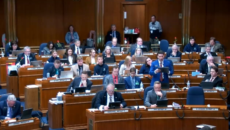Dorso Column: Things Change Quickly At The End Of The Legislative Session

The last few weeks of the legislative session are here. As the standing committees act on the last of the bills assigned to them we need to pay close attention. Amendments to Senate bills and vice versa can radically change a piece of legislation.
As an example, a bill passed in the House goes over to the Senate where it is heard again. The Senate committee votes out an amendment which is passed by the full body. The House bill is now the senate version. The Senate passes the new version and it is sent back to the House for its consideration.
Generally from that point this is how it works. The chairman of the standing committee that acted on the bill in the House reviews the changes made by the Senate. If the bill had legislative sponsors in the house they are consulted as to their feelings about the amendments made in the Senate. If no one has any objections to the amendments the senate version is put on the calendar for a final vote in the House. Since the Senate version has now been approved by the House once it is passed it goes to the governor for his signature.
It is at this point, due to the large Republican majorities, when the minority Democrats become somewhat irrelevant to the process. What really counts is whether the Senate Republicans and House Republicans can find compromise on the different versions of the legislation.
The interesting dynamic is when the House doesn’t agree with the amendments the Senate made to the house bill or vice versa. A motion is made on the floor to not agree with the Senate amendments and that the Speaker of the House appoints a committee of three to meet with a like committee from the Senate. The motion in the Senate is that the House has not agreed to the amendments and a committee be appointed.
On most bills going to conference the chairman of the respective standing committee, which originally heard the bill, names the conferees. A piece of paper is submitted to the Majority Leaders office with three member’s names. By rule the three are made up of two from the majority party and one from the minority. Sometimes the Majority Leader will not agree to the conferees chosen by the chairman and will request that different people be selected. In my time all conference committee selections went across my desk before the Speaker announced the conferees on the house floor.
The complete set of rules by which conference committees are appointed and how they operate are contained in two documents. Joint rule 301 is adopted by each chamber at the beginning of each session which includes references to Mason’s Manual of Legislative Procedure. Mason’s is something like Roberts Rule of order but developed for legislative bodies. The basic premise is that the majority party in each legislative chamber controls who serves on the conference committees and that an agreement of the two majorities must occur before the legislation can move forward.
The object is to find people knowledgeable about the content of the bill in question. When selecting the minority member you try to get someone who is reasonable and wants the bill to pass in some version. That sometimes is difficult because of the small numbers the Democrats have in the house. A small percentage of total membership means few members on standing committees. If the committee has only a couple of reasonable Democrats to pick from those few become very busy while the others are left to while away their time.
I’ll digress here to point out that it is at this point when legislative leadership really begins to assert itself. Members of the Republican caucus who are not in the main stream find themselves on very few conference committees. Leadership is trying to make sure that the conferees reflect the views of the caucus. Thus you find some members of the Republican caucus and many Democrats without much to do. There is always some danger in that. As the saying goes “an idle mind is the devils play ground.” You don’t want too many disgruntled legislators wondering around trying to figure out how to throw a monkey wrench into the machinery. You also want to keep the minority party engaged so you seek the Minority Leaders advice on who they would appoint to a conference committee. Most of the time the Minority Leaders understand the need to move the legislation and are cooperative but at times you do have to overrule their choices on certain legislation.
Once the conferees are appointed the chairman of the committee is picked. The chair is from the Majority party of the chamber where the bill originated. The majority party needs a chairman who is familiar with the subject and has experience with the rules the conference committee operates under. A conference committee chair has a lot of power. They must schedule a committee meeting within two days of being named. That does not mean they have to take action. I have seen times when chairman convened a meeting only to adjourn immediately. Sometimes that is because one or more of the conferees is not available because they are working on other committees. Sometimes it is because they want to see how another piece of legislation is handled in another conference committee. As an example how are state employee benefits being handled in a certain appropriation bill? For the most part you want employee benefits to be more or less the same across all of the appropriations bills that deal with the matter.
An interesting part of the conference committee rules are that only the differences between the two versions are up for debate. Thus one needs to pay attention to the amendments adopted by the last house to act on a bill. Amendments are sometimes added to a bill just so that portion of the legislation can be debated in conference.
I’ll have more on the process in my next column. I see some interesting times ahead for Appropriations bills dealing with higher ed, state employee retirement packages and more. Stay tuned.







